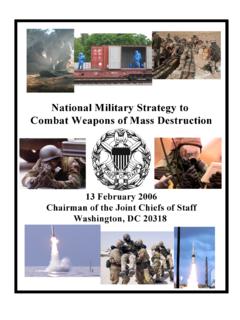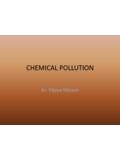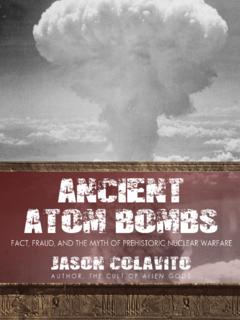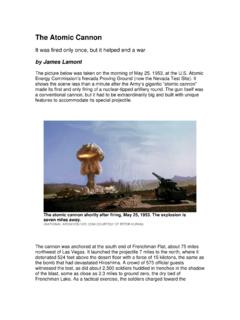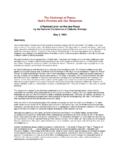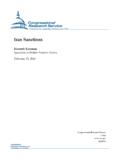Transcription of The Effects Nuclear Weapons - Atomic Archive
1 TheEffectsofNuclearWeaponsCompiled and edited bySamuel Glasstone and Philip J. DolanThird EditionPrepared and published by theUNITED STATES DEPARTMENT OF DEFENSEand theENERGY RESEARCH AND DEVELOPMENT ADMINISTRATION.~~~~-'!l -:8~" ,,-".,,~ ..01977, ,." .J!'or sale by the Superintendent of Documents, Government Printing OlBceWashln~ton. 20402'" ; Iib',c IPREFACEWhen "The Effects of Atomic Weapons " was published in 1950, the explosiveenergy yields of the fission bombs available at that time were equivalent to somethousands of tons ( , kilotons) of TNT. With the development of thermonuclear(fusion) Weapons , having energy yields in the range of millions of tons ( ,megatons) of TNT, a new presentation, entitled "The Effects of Nuclear Weap-ons," was issued in 1957. A completely revised edition was published in 1962 andthis was reprinted with a few changes early in the last version of "The Effects of Nuclear Weapons " was prepared, muchnew information has become available concerning Nuclear Weapons Effects .
2 Thishas come in part from the series of atmospheric tests, including several at very highaltitudes, conducted in the Pacific Ocean area in 1962. In addition, laboratorystudies, theoretical calculations, and computer simulations have provided a betterunderstanding of the various Effects . Within the limits imposed by security re-quirements, the new information has been incorporated in the present edition. Inparticular, attention may be called to a new chapter on the electromagnetic should emphasize, as has been done in the earlier editions, that numericalvalues given in this book are not-and cannot be-exact. They must inevitablyinclude a substantial margin of error. Apart from the difficulties in makingmeasurements of Weapons Effects , the results are often dependent upon circum-stances which could not be predicted in the event of a Nuclear attack.
3 Furthermore,two Weapons of different design may have the same explosive energy yield, but theeffects could be markedly different. Where such possibilities exist, attention iscalled in the text to the limitations of the data presented; these limitations should notbe material is arranged in a manner that should permit the general reader toobtain a good understanding of the various topics without having to cope with themore technical details. Most chapters are thus in two parts: the first part is written ata fairly low technical level whereas the second treats some of the more technical andmathematical aspects. The presentation allows the reader to omit any or all of thelatter sections without loss of choice of units for expressing numerical data presented us with a exclusive use of international (SI) or metric units would have placed a burdenon many readers not familiar with these units, whereas the inclusion of both SI andcommon units would have complicated many figures, especially those with ilogarithmic scales.
4 As a compromise, we have retained the older units and added anexplanation of the SI system and a table of appropriate conversion factors.,iPrefaceMany organizations and individuals contributed in one way or another to thisrevision of "The Effects of Nuclear Weapons ," and their cooperation is gratefullyacknowledged. In particular, we wish to express our appreciation of the help givenus by L. J. Deal and W. W. Schroebel of the Energy Research and DevelopmentAdministration and by Cmdr. H. L. Hoppe of the Department of GlasstonePhilip J. Dolan~:IIII,IIIIACKNOWLEDGEMENTSP reparation of this revision of "The Effects of Nuclear Weapons " was madepossible by the assistance and cooperation of members of the organizations of DefenseHeadquarters, Defense Nuclear AgencyDefense Civil Preparedness AgencyArmed Forces Radiobiology Research InstituteV.
5 S. Army Aberdeen Research and Development Center, Ballistic Research Army Engineer Waterways Experiment StationNaval Surface Weapons CenterDepartment of Defense ContractorsStanford Research InstituteGeneral Electric, TEMPOM ission Research CorporationDepartment of CommerceNational Oceanic and Atmospheric AdministrationAtomic Energy Commission!Energy Research and Development AdministrationHeadquarters Divisions and the laboratories:Brookhaven National LaboratoryHealth and Safety LaboratoryLawrence Livermore LaboratoryLos Alamos Scientific LaboratoryLovelace Biomedical and Environmental Research LaboratoriesOak Ridge National LaboratorySandia Laboratoriesi!CONTENTSPageCHAPTER I-General Principles of Nuclear Explosions. ICharacteristics of Nuclear Explosions. IScientific Basis of Nuclear Explosions. 12 CHAPTER II-Descriptions of Nuclear Explosions.
6 26 Introduction. 26 Description of Air and Surface Bursts. 27 Description of High-Altitude Bursts. 45 Description of Underwater Bursts. 48 Description of Underground Bursts. 58 Scientific Aspects of Nuclear Explosion Phenomena. 63 CHAPTER III-Air Blast Phenomena in Air and Surface Bursts. 80 Characteristics of the Blast Wave in Air. 80 Reflection of Blast Wave at a Surface. 86 Modification of Air Blast Phenomena. 92 Technical Aspects of Blast Wave Phenomena. 96 CHAPTER IV-Air Blast Loading 127 Interaction of Blast Wave with Structures. 127 Interaction of Objects with Air Blast. 132 CHAPTER V -Structural Damage from Air Blast. 154 Introduction 154 FactorsAffectingResponse , 156 Commercial and Administrative Structures. 158 IndustriaIStructures 165 ResidentiaIStructures 175 Transportation 189 Utilities. 195 MiscellaneousTargets 206 Analysis of Damage from Air Blast 212 CHAPTER VI-Shock Effects of Surface and Subsurface Bursts.
7 231 Characteristics of Surface and Shallow Underground Bursts. 231 Deep Underground Bursts 238 Damage to Structures. 241 Characteristics of Underwater Bursts. 244 ITechnical Aspects of Surface and Underground Bursts. 253 Technical Aspects of Deep Underground Bursts. 260 IJoading on Buried Structures. 263 DamagefromGroundShock 265 Technical Aspects of Underwater Bursts. 268 CHAPTER VII-Thermal Radiation and Its Effects . 276 RadiationfromtheFireball 276 Thermal Radiation Effects 282 Incendiary Effects . 296 IncendiaryEffectsinJapan 300 Technical Aspects of Thermal Radiation. 305 Radiant Exposure-Distance Relationships. 316 CHAPTER VIII-Initial Nuclear Radiation. 324 Nature of Nuclear Radiations 324 Gamma Rays. 326 Neutrons. 340 Transient-Radiation Effects on Electronics (TREE) 349 Technical Aspects of Initial Nuclear Radiation.
8 353 CHAPTER IX-Residual Nuclear Radiation and Fallout. 387 Sources of Residual Radiation. 387 Radioactive Contamination from Nuclear Explosions. 409 Fallout Distribution in Land Surface Bursts. 414 Fallout Predictions for Land Surface Bursts. 422 Attenuation of Residual Nuclear Radiation. 439 Delayed Fallout..'.' 442 Technical Aspects of Residual Nuclear Radiation. 450 CHAPTER X-Radio and Radar Effects . 461 Introduction 461 Atmospheric Ionization Phenomena. 462 Ionization Produced by Nuclear Explosions 466 Effects on Radio and Radar Signals. 479 Technical Aspects of Radio and Radar Effects . 489 CHAPTER XI-The Electromagnetic Pulse and its Effects . 514 OriginandNatureoftheEMP 514 EMP Damage and Protection 523 Theory of the EMP 532 CHAPTER XII-Biological Effects . 541 Introduction 541 Blast Injuries. 548 BurnInjuries 560 Nuclear Radiation Injury.
9 575,'-Characteristics of Acute Whole-Body Radiation Injury. 583 Combined Injuries. 588 Late Effects of Ionizing Radiation. 589 Effects of Early Fallout 594 Long-Term Hazard from Delayed Fallout. 604 Genetic Effects of Nuclear Radiation. 609 Pathology of Acute Radiation Injury. 614 Blast-RelatedEffects 618 Effects on Farm Animals and Plants. 618 Glossary. 629 GuidetoSIUnits 642 Index. 644~ii!!rrCHAPTER VIITHERMAL RADIATION AND ITS EFFECTSRADIATION FROM THE FIREBALLGENERAL CHARACTERISTICS OF energy is initially in the form of kineticTHERMAL RADIATION energy of the weapon debris. This ki-netic energy is also absorbed by the One of the important dif- at a slightly later time ( ) andferences between a Nuclear and a con- serves to further heat the air. The heatedventional high-explosive weapon is the air, which constitutes the fireball, in turnlarge proportion of the energy of a nu- radiates in a spectral region roughlyclear explosion which is released in the similar to that of sunlight near theform of thermal (or heat) radiation.
10 Be- earth's surface. It is the radiation (ultra-cause of the enormous amount of energy violet, visible, and infrared) from theliberated per unit mass in a Nuclear fireball, traveling with the velocity ofweapon, very high temperatures are at- light, which constitutes the thermal ra-tained. These are estimated to be several diation at distances from the of million degrees, compared with The time elapsing, therefore, betweena few thousand degrees in the case of a the emission of this (secondary) thermalconventional explosion. As a conse- radiation from the fireball and its arrivalquence of these high temperatures, at a target miles away, is quite msignif-about 70 to 80 percent of the total en- (excluding the energy of the resid- It is desirable to state specific-ual radiation) is released in the form of ally what is meant by the term "thermalelectromagnetic radiation of short radiation" as it is used in the presentwavelength.

